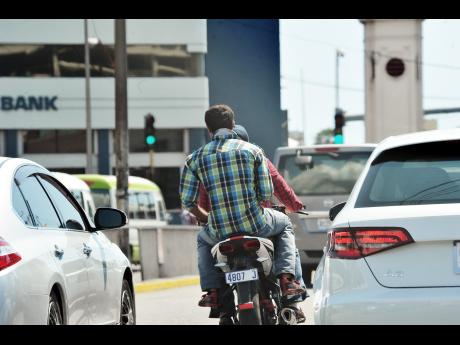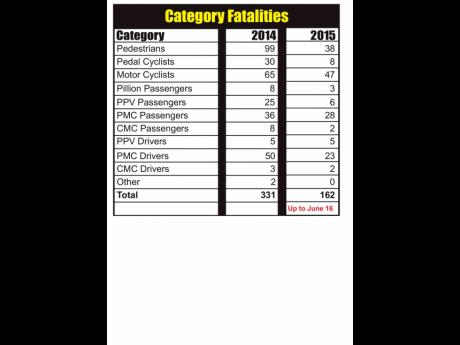Motorcyclists top road fatalities since the start of the year
Despite a record-breaking number of fatalities last year (65) motorcyclists continue to flout the law while putting themselves and others at risk by not wearing the proper safety gear and seem determined to ensure the death toll record is broken again this year.
According to data from the Road Safety Unit of the Ministry of Transport, at least 50 motorcyclists have died on the nation's roads so far this year. This is 10 more than the number of pedestrians to die on the roads and, at the present pace, if left unchecked, could result in a record 80 motorcyclists deaths this year.
"These road users need to understand that they are operating a very dangerous motor vehicle," director of the Road Safety Unit, Kenute Hare, told The Sunday Gleaner.
"That vehicle loves the ground, so it therefore means we who are riding this vehicle need to ensure that we have on the proper safety gear, that we obey the rules and regulations that govern how the vehicle should be operated on the road and ensure that we have the requisite skills to operate these bikes," added Hare.
None of the motorcyclists killed so far this year was wearing a helmet and all are males with the majority between the ages of 25 and 36.
Difficult to police
Now, the police want to clamp down on these young daredevils but head of the island's traffic division, Senior Superintendent Calvin Allen, admits that the policing and seizure of motorcycles have proven to be difficult tasks.
"It is very challenging because these guys are able to dally through the traffic and the precautions that the policemen will take those guys are not taking those precautions, because their intention is just to get away," said Allen.
He pointed out that most of the breaches in terms of proper registration and licensing are committed in the western end of the island with Westmoreland, St James and St Elizabeth at the top of the list.
"If you drive to Westmoreland right now and go to the Savanna-la-mar police station more than 400 seized motorcycles are parked up inside that station," noted Allen.
"And ironically the owners are not coming back to claim the bikes, but you will see them the next day on another bike. A lot of free money seems to be dropping from the sky down that end, but there is the whole lotto scam and all that."
The majority of the 50 motorcyclists that have lost their lives since the start of the year were from Westmoreland, as 13 bike riders have died from that parish. Motorbikes are used as taxis in the parish, but most of the accidents occur when the bikers are on joyrides.
Don't know how to ride
According to Hare, the inability of some motor-cyclists to ride properly, non-adherence to the rules of the road and the failure to wear proper protective gear are some of the main reasons why so many of them are losing their lives.
"They don't know how to ride properly. They're not breaking properly. They're not turning properly and they're speeding," Hare said while pointing out that riders have a tendency to depend heavily on the back break and do not like to use the front break resulting in them being thrown to the ground.
"We also have to get them to understand that they are supposed to use the road like how cars use the road," said Hare.
"They shouldn't't be overtaking, undertaking people and driving on white lines. The same way how you see cars behind each other in the traffic, that is how they are supposed to operate."
According to the World Health Organisation wearing a motorcycle helmet correctly can reduce the risk of death by almost 40 per cent and the risk of severe injury by over 70 per cent.
But Hare revealed that despite the protective device law coming into effect in 1999 it has been a challenge to get riders to wear helmets and other protective devices.
"They are not wearing the helmet. They don't wear elbow pads. They're not wearing knee pads and they're not wearing jackets," Hare said. "In the case of collisions, they end up falling from the bikes and their head connects with the asphalt and when it connects with the asphalt, it is not the asphalt that is going to deform, it is normally the head and the brain. So, they suffer from a lot of head injuries and brain injuries."



